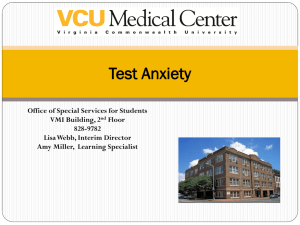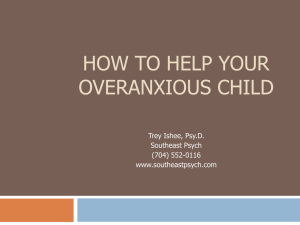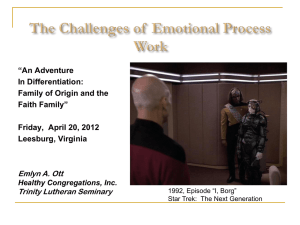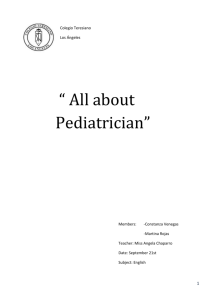Module 2: Anxiety (Streaming)
advertisement
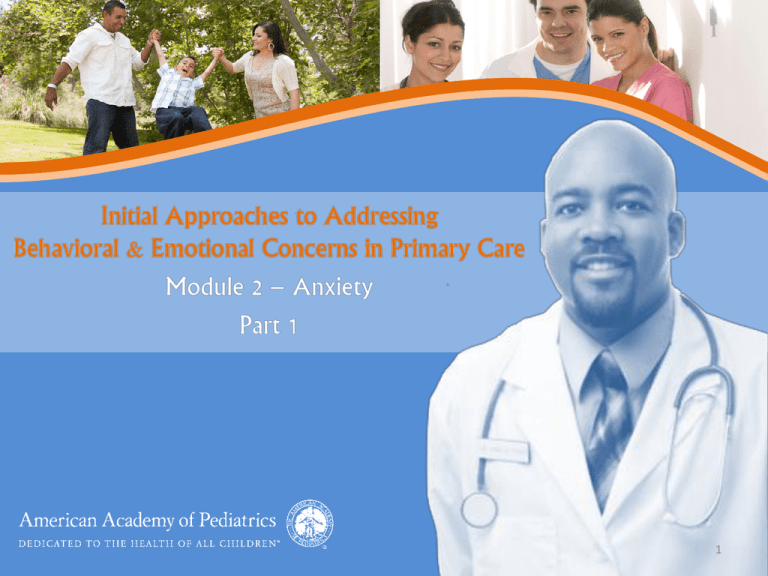
1 Goals & Objectives Goal: Recognize and manage in the primary care setting children and youth with mild to moderate anxiety Objective 1: Appreciate that anxiety symptoms and disorders commonly present in primary care and may represent typical behavior, a primary anxiety concern, and/or be secondary to other conditions or events Objective 2: Know and recognize the common symptoms and clinical findings in children and youth that suggest anxiety at different developmental stages Objective 3: Utilize a common factors approach to assess and manage children and youth with anxiety 2 Anxiety: Brief Review • Anxiety is influenced by genetic & environment – Common and unusual events – Occasionally medications and medical disorders • Anxiety is common and can be adaptive – Mild levels can be protective and facilitate task completion • Anxiety disorders occur when anxiety interferes with functioning and/or causes distress – 6% to 20% childhood prevalence 3 Anxiety: Brief Review Anxiety changes with age and developmental stage • Toddler/Preschool: separation, strangers, imaginary creatures • Early School Age: separation, being alone, physical harm to self or parents • Late elementary to middle school: performance, health or harm, social • Adolescence: Performance, social, not fitting in with peers 4 Anxiety Management Intervention strategies • Express hope that the child will learn to adapt (common factors) • Reduce stress, but don’t avoid developmentally appropriate activities • Gradually increase exposure to feared objects or experiences – Imagining exposure, tolerating brief exposure, increasing exposure time – Getting closer to a feared object – Rewards often helpful to motivate child 5 Anxiety Management • Teach anxiety symptom management strategies – Cognitive • Understand biological response to fear/anxiety • Develop helpful thoughts instead of fear inducing thoughts – Distraction and/or relaxation • Bubbles / deep breathing • Progressive muscle relaxation – Give child control • Fixed choices • Super powers • Psychopharmacological interventions (not discussed in this module) 6 Anxiety Management Refer when anxiety… • Causes severe impairment or moderate impairment in multiple settings • Occurs after a severe psychosocial stressor • Occurs in context of marital discord, or parental psychopathology/severe family stressors • Is not improving despite intervention in primary care 7 Common Factors Review H E 2 L Hope: for improvement, identify strengths Empathy: listen attentively Language: use family’s language, check understanding Loyalty: express support and commitment Permission: ask permission to explore sensitive subjects, P 3 offer advice Partnership: identify and overcome barriers Plan: establish plan or at least a first step family can do 8 Case #1 You are seeing Ben, a 3 ½-year-old boy, whose parents come in together due to concerns about his tantrums when dropped off at child care. He is a healthy child who you last saw for his 3 year well-child visit. During that visit there were no concerns raised about his behavior or development (he passed his 3-year-old developmental screen), but his mother had expressed concern about how Ben would do in child care now that she was going back to work. The parents were able to meet with you without Ben present. 9 Case #1 | Video #1 While watching this video, think about the following questions: • What does the pediatrician do well in approaching this case? • What could the pediatrician have done differently or better? – Note how the pediatrician discourages discussion of parental concerns 10 Click here to play video from Internet: https://www.youtube.com/v/tSnF2NAy3ns 11 Pediatrician Responses That Discouraged Discussion • Ignored the problem, changed subject • Changed the problem – After little exploration, minimized the problem or reframed to detract from legitimacy or importance • Overly authoritative response – Confident, simplistic and often scripted advice • Powerless to help – Ambiguous advice or acknowledged inability to help without offering additional resources 12 Case #1: Discussion of Video #1 • What additional history would you want to obtain? • Using a common factors approach, how might you approach this situation differently? 13 Case #1 | Video #2 While watching this video, think about the following questions: • What aspects of this case are typical for a child with separation anxiety? What aspects are unusual? • How did the pediatrician use a common factors approach? – Notice how the common factors approach can help to elicit additional history important in understanding the situation 14 Click here to play video from Internet: https://www.youtube.com/v/ElniRiDgRyQ 15 Case #1: Potential Barriers to Intervention Child Factors Parent Factors School/Community Factors 16 What are some potential management strategies to address this child’s separation anxiety? 17 18 Case #2 You are seeing Maria, an 11 year-old girl for a wellchild visit and school physical. You last saw her for her 10-year well-child visit. She has no chronic medical problems and has been growing and developing well. She comes to your office with her mother. You discover she is having frequent episodes of abdominal pain. 19 Case #2 | Video #1 While watching this video, think about the following questions: • What does the pediatrician do well in approaching this case? • How did the pediatrician use a common factors approach to obtain the history? • What are possible causes of this child’s symptoms? 20 Click here to play video from Internet: https://www.youtube.com/v/MQ1lUNHXXh4 21 Case #2: Key History Reviewed • School nurse calls Maria’s mother about 3 times per week and her mother picks her up from school. Pain typically occurs before math class. • Pain is perumbilical, crampy, and seems to improve after she gets home and rests. • Additional family stressors – Mother is missing work, father is traveling for business. • Maria is growing and gaining weight appropriately and the physical exam is unremarkable. • What additional history would you like to obtain? 22 Case #2 | Video #2 While watching this video, think about the following questions: • How did the physician use a common factors approach to develop next steps? • What factors were typical for a child with school avoidance? What factors were unusual? • What are possible long-term sequelae if school avoidance is not successfully addressed? 23 Click here to play video from Internet: https://www.youtube.com/v/8WGpS2SALb4 24 Common Factors Approach Demonstrated Hope: “If we work together I think we can figure this out” Language: Discusses medical & psychological factors together Permission: Defines the 2 goals for the visit 25 Common Factors Approach Demonstrated Partnership: Develops partnership with parent • Addressing her concern about her job Develops partnership with Maria • Asking her to be a detective • Making it her job to complete the diary 26 What are some additional management strategies that may have been reasonable to address this child’s school avoidance? 27



